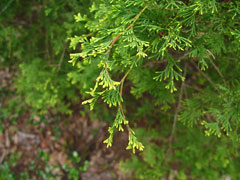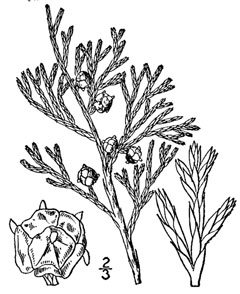 |
|
http://commons.wikimedia.org/wiki/User:Crusier |
 |
| USDA-NRCS PLANTS Database / Britton, N.L., and A. Brown. 1913. Illustrated flora of the northern states and Canada. Vol. 1: 65. |
Translate this page:
Summary
Main Bloom Time: Early spring, Late spring, Mid spring. Form: Columnar, Oval, Pyramidal.
Physical Characteristics

 Chamaecyparis thyoides is an evergreen Tree growing to 10 m (32ft) by 3 m (9ft) at a slow rate.
Chamaecyparis thyoides is an evergreen Tree growing to 10 m (32ft) by 3 m (9ft) at a slow rate.
See above for USDA hardiness. It is hardy to UK zone 5. It is in leaf all year, in flower from March to April, and the seeds ripen from September to October. The species is monoecious (individual flowers are either male or female, but both sexes can be found on the same plant) and is pollinated by Wind.
It is noted for attracting wildlife.
Suitable for: light (sandy), medium (loamy) and heavy (clay) soils, prefers well-drained soil and can grow in heavy clay soil. Suitable pH: mildly acid, neutral and basic (mildly alkaline) soils and can grow in very acid and very alkaline soils.
It can grow in semi-shade (light woodland) or no shade. It prefers dry moist or wet soil. The plant can tolerates strong winds but not maritime exposure.
It cannot tolerate atmospheric pollution.
UK Hardiness Map
US Hardiness Map
Synonyms
C. sphaeroidea. Cupressus thyoides. Thuja sphaeroidea.
Plant Habitats
Woodland Garden Canopy; Hedge; Bog Garden;
Edible Uses
References More on Edible Uses
Medicinal Uses
Plants For A Future can not take any responsibility for any adverse effects from the use of plants. Always seek advice from a professional before using a plant medicinally.
A decoction of the leaves has been used as a herbal steam for treating headaches and backaches[257]. A poultice made from the crushed leaves and bark has been applied to the head to treat headaches[257].
References More on Medicinal Uses
The Bookshop: Edible Plant Books
Our Latest books on Perennial Plants For Food Forests and Permaculture Gardens in paperback or digital formats.

Edible Tropical Plants
Food Forest Plants for Hotter Conditions: 250+ Plants For Tropical Food Forests & Permaculture Gardens.
More

Edible Temperate Plants
Plants for Your Food Forest: 500 Plants for Temperate Food Forests & Permaculture Gardens.
More

More Books
PFAF have eight books available in paperback and digital formats. Browse the shop for more information.
Shop Now
Other Uses
Hedge Hedge Wood
Plants can be grown as a tall hedge[200] They are very tolerant of clipping so long as this does not extend into the brown barked wood since trees cannot regenerate from this[200]. Any trimming should be done in the summer[200]. Wood - soft, not strong, close grained, very durable, easily worked, light, slightly fragrant. It weighs 21lb per cubic foot. It is commonly used for woodenware, cooperage, fence posts, interior finish of houses etc[43, 46, 61, 82, 171, 235]. Wood found buried in swamps for hundreds of years is perfectly sound and not water-logged[11].
Special Uses
Attracts Wildlife Hedge Hedge Scented Plants
References More on Other Uses
Cultivation details
Landscape Uses:Pest tolerant, Screen, Specimen. Succeeds in most soils and situations, but prefers abundant moisture and a deep loamy soil and a sheltered position[1, 11]. Grows well in heavy clay soils. Survives on dry alkaline soils[200]. Growth of trees is hardly affected by a lack of phosphate in the soil. Plants are moderately shade tolerant, especially when young[81, 200]. Plants are tolerant of atmospheric pollution according to one report[200], whilst another says that they do not do well in a polluted atmosphere[1]. This species is especially well adapted for planting in cold wet places[1]. Plants are hardy to about -35°c[200]. A long-lived tree in the wild with specimens more than 1,000 years old[229]. It is slow growing in cultivation[200], trees rarely grow more than 20cm in a year[185]. The branches become brittle with age[1]. A very polymorphic species, there are many named varieties[200]. The crushed foliage has a rather gingery hot aroma[185]. Favoured by many birds for roosting, high cover and especially for nesting, large specimens of this tree help to attract songbirds to the garden[200]. Trees are notably susceptible to honey fungus[200]. Special Features:Attracts birds, North American native, Wetlands plant, Inconspicuous flowers or blooms.
References Carbon Farming Information and Carbon Sequestration Information
Temperature Converter
Type a value in the Celsius field to convert the value to Fahrenheit:
Fahrenheit:
The PFAF Bookshop
Plants For A Future have a number of books available in paperback and digital form. Book titles include Edible Plants, Edible Perennials, Edible Trees,Edible Shrubs, Woodland Gardening, and Temperate Food Forest Plants. Our new book is Food Forest Plants For Hotter Conditions (Tropical and Sub-Tropical).
Shop Now
Plant Propagation
Seed - sow March/April in a seedbed outdoors[78]. The seed is best sown in pots in a frame[K]. Seed can take 18 months to germinate. One month warm then one month cold stratification has produced good results[113]. When large enough to handle, prick the seedlings out into individual pots and grow them on in a cold frame for their first winter, planting them out in late spring after the last expected frosts. Cuttings in late summer or autumn in sandy soil in a cold frame[1, 11, 200]. Difficult, it may be best done in late winter to early spring[113].
Other Names
If available other names are mentioned here
Native Range
NORTHERN AMERICA: United States (Connecticut, Maine (c.), Massachusetts, New Hampshire, New Jersey, New York, Pennsylvania, Rhode Island, Alabama, Delaware, Florida (north), Georgia, Maryland, Mississippi, North Carolina, South Carolina, Virginia)
Weed Potential
Right plant wrong place. We are currently updating this section.
Please note that a plant may be invasive in one area but may not in your area so it's worth checking.
Conservation Status
IUCN Red List of Threatened Plants Status :

Growth: S = slow M = medium F = fast. Soil: L = light (sandy) M = medium H = heavy (clay). pH: A = acid N = neutral B = basic (alkaline). Shade: F = full shade S = semi-shade N = no shade. Moisture: D = dry M = Moist We = wet Wa = water.
Now available:
Food Forest Plants for Mediterranean Conditions
350+ Perennial Plants For Mediterranean and Drier Food Forests and Permaculture Gardens.
[Paperback and eBook]
This is the third in Plants For A Future's series of plant guides for food forests tailored to
specific climate zones. Following volumes on temperate and tropical ecosystems, this book focuses
on species suited to Mediterranean conditions—regions with hot, dry summers and cool, wet winters,
often facing the added challenge of climate change.
Read More
Expert comment
Author
(L.)Britton.Stern.&Pogl.
Botanical References
1143200
Links / References
For a list of references used on this page please go here
Readers comment
| Add a comment |
|
If you have important information about this plant that may help other users please add a comment or link below. Only comments or links that are felt to be directly relevant to a plant will be included. If you think a comment/link or information contained on this page is inaccurate or misleading we would welcome your feedback at [email protected]. If you have questions about a plant please use the Forum on this website as we do not have the resources to answer questions ourselves.
* Please note: the comments by website users are not necessarily those held by PFAF and may give misleading or inaccurate information.
To leave a comment please Register or login here All comments need to be approved so will not appear immediately.
|
Subject : Chamaecyparis thyoides
|
|
|
|